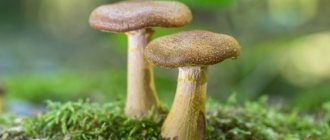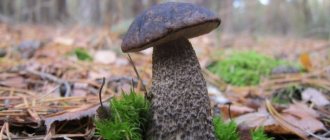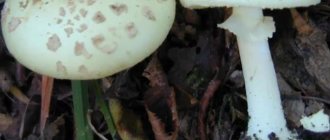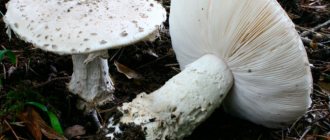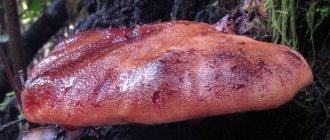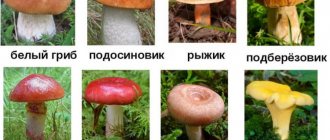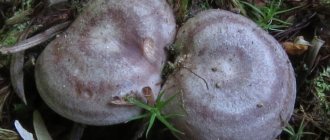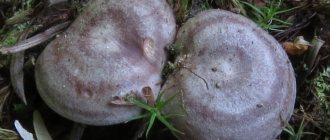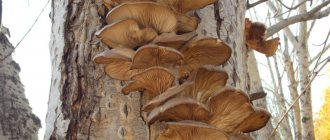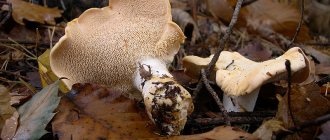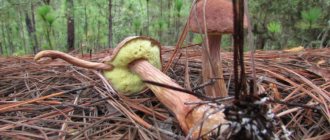Honey mushrooms are very popular fruiting bodies among a large number of mushroom pickers. Most often they grow in large groups on one tree or stump. Even the name “honey agaric” itself suggests the idea of a mushroom growing on a stump. Indeed, almost all types of honey mushrooms love to settle on old rotten stumps, as well as on trees fallen by windfall, large fallen branches and on diseased trees and shrubs. Sometimes these fruiting bodies settle on living plants, leading to their death. There are exceptions - meadow honey mushrooms, which choose as their habitat ravines, pastures, alder forests with high humidity, fields, forest clearings and the sides of paths.
False honey mushrooms - the most common types
It should be noted right away that false honey fungus is not a completely accurate term, since this name is applied to several independent types of mushrooms at once.
Of course, they are all more or less similar in appearance and generally imitate real honey mushrooms. These are mainly small lamellar mushrooms with a cap diameter of no more than 5-7 cm and a stem length of less than 10 cm, growing in large groups on dead wood, including rotting wood. It is noteworthy that not all of them are strictly poisonous. Some species are quite edible, or are considered as such in other countries. However, we do not recommend taking risks and suggest limiting yourself to collecting only real honey mushrooms, the edibility of which is not in question.
So, the category of false honey mushrooms includes the following types:
- False honey fungus is sulfur-yellow. A small poisonous mushroom, colored pale yellow, sulfur-yellow or yellowish-brown. The central part of the cap is darker than its edges. Sometimes, although not always, the plates on the underside of the cap may have a greenish tint, which is how this mushroom can be identified. Sulfur-yellow false honey fungus grows in summer and autumn mainly in deciduous forests and extremely rarely in coniferous forests.
- Seroplate or poppy honey fungus. It is classified as a good edible mushroom, which in general is very similar to the summer honey mushroom both in appearance and in taste. The cap of young fruiting bodies is hemispherical in shape; as it ages, it becomes flattened. The color is very dependent on the level of humidity: in dry weather the cap has a dull yellow tint with a slightly more saturated center; with increasing humidity, the color scheme becomes more saturated, close to light brown. The leg near the ground is rusty brown, closer to the cap it is yellow. The peculiarity of this species is that it grows exclusively in coniferous forests, especially preferring pine and spruce. The fungus is distributed throughout the temperate zone and is found throughout the warm period of the year.
- False honey fungus is brick-red. Due to its strong bitterness, in Europe it is considered an inedible or conditionally edible (long boiling is required) mushroom of low quality. At the same time, in the USA and Japan, for some reason, this mushroom has gained enormous popularity. This species is larger than ordinary honey mushrooms (caps sometimes grow more than 10 cm). The shape of the cap is convex, then flattens with age. The color is mainly red-brown, lighter or darker shades are possible. The center of the cap is always darker. The color of the leg is pale yellow at the top and brownish at the ground. The fungus grows from summer to autumn on any dead wood.
- Candoll's false honey fungus. Previously it was considered an inedible or even poisonous mushroom. Today this species is classified as conditionally edible (preliminary boiling is required). The cap of young mushrooms is bell-shaped, then becomes flattened, maintaining a slight elevation in the center. Color varies from almost white to yellowish brown. Residual fragments of the bedspread are visible along the edge. The leg is whitish-cream in color. The mushroom bears fruit from May to September in forests and more open areas.
- The honey fungus is watery. The edibility of this mushroom has not been established. Young mushrooms have a convex or bell-shaped cap, which flattens with age. The color range depends on the humidity level and varies from rich brown to cream. The leg is almost always pale in color. The mushroom bears fruit in June - October.
It should be noted that the term “false honey fungus” also applies to some other species that we have not mentioned here. However, only the above-mentioned mushrooms actually grow on old stumps and dead wood, and therefore they can indeed be mistaken for honey mushrooms. There is no point in mentioning all other mushrooms that outwardly resemble honey mushrooms, but grow on the ground or in moss, since real honey mushrooms grow only on wood.
Summer honey mushrooms
As for the summer representatives of the culture we are considering, you can enjoy them from May to September. The ideal habitat for the species is rotten trees and half-decomposed wood where high humidity is maintained. For example, near streams.
What a summer honey fungus looks like depends on weather conditions. If dampness prevails in the region and precipitation occurs frequently, the mushroom cap darkens from the middle to the edges. In drought conditions, the cap becomes one-color, light brown. The spores are brown in color, while in winter representatives they are light. The older the “individual”, the darker its color.
Experienced mushroom pickers advise caution when collecting summer mushrooms, as there is a high probability of confusing them with their poisonous counterparts. The main rule in this case is not to harvest in a forest with a predominance of coniferous trees, as well as directly on the stumps of resin-containing crops
Autumn honey fungus: what it looks like, photo
Autumn mushrooms are considered the most aromatic and delicious in many regions of our country. Today we will look at such a variety of mushroom as the autumn honey fungus - its description, as well as the principles by which one can determine whether the fruit is edible for the collector.
Grains on the cap.
Description
Before discussing the appearance of the autumn honey mushroom, it is important to determine the ripening period of the variety. As a rule, the harvest can be harvested starting from the last week of August and throughout September - it all depends on the climatic conditions of each individual region. Honey mushrooms grow in colonies, so-called waves, the first “influx” is usually the most abundant, the subsequent ones decline. Each wave lasts from several days to a week, and the fruits can disappear very suddenly. You can predict their appearance by focusing on precipitation - mushroom pickers prefer to scout the forest belt a few days after heavy rain.
Let's move on to how to distinguish autumn honey mushrooms from other varieties of the family or other inedible crops:
- Autumn honey fungus is distinguished by its cap bent inward. The head of the mushroom resembles half a neat ball, the maximum diameter is no more than 16 centimeters. The optimal size of a young but mature fruit is up to 10 centimeters at the top and 6-10 centimeters at the widest part of the mushroom. The color is creamy-brown; a small tubercle often grows in the center of the cap. The surface is covered with small scales.
- The fetal leg becomes thinner at the point of contact with the cap, is quite stable, and is bordered by a light ring of film. The average thickness is 1-1.5 centimeters.
- The spores of the fungus are white-yellow in color, the plates are thin and multiple, they can change color from light to brown, descending.
The pulp of the delicacy is light, dense in texture, exudes a persistent mushroom aroma and is slightly sour. The fruit is completely edible, but some mushroom pickers prefer not to eat the stems of the plant - they are fibrous and tougher.
Where does it grow
As for habitats, the most favorable substrate for the variety we are considering is non-living wood of fallen deciduous trees, stumps, etc. It is believed that more honey mushrooms can be found on trees that have fallen close to the stream, in conditions of high humidity. Look carefully where the crop grows - inedible specimens most often develop on coniferous wood.
Prevention of poisoning
Every person knows from childhood that you need to pick a mushroom only when you are sure of its edibility. Failure to follow this simple rule can lead to serious poisoning or even death.
Let's talk about precautions that every mushroom picker needs to remember, regardless of experience.
First of all, it is worth remembering that almost every mushroom has an inedible double - that’s how nature works. Therefore, under no circumstances should you blindly harvest without checking the product in all respects.
- Before each visit to the forest, make sure that you remember all the distinctive features of the mushroom that you plan to collect. If in doubt, find a photo of the plant and refresh your memory of what it looks like.
- Inexperienced mushroom pickers are recommended to study all types of forest “gifts”, similar, in our case, to honey fungus. If a person is not confident in his own memory, you can even print out a photo of the fetus and take it with you. Then you will definitely be able to avoid a dangerous mistake.
- It is strictly forbidden to listen to the advice of frivolous forest lovers - there are often beliefs that Russian forests are free of poisonous plants. This is wrong.
Since we are talking about autumn honey mushrooms, we will give an example of their counterparts - false honey mushrooms. They are inedible and even dangerous to health, while in appearance they look more like summer representatives than autumn ones. There may be several false relatives of the mushroom we are considering - some are simply unsuitable for food, others are downright poisonous.
To protect yourself, pay attention to the presence of a film ring around the stem of the mushroom. Edible representatives have this ring, while inedible representatives do not. The color is also important - in the first case the color of the cap is less attractive, in the second it is brighter. Real honey mushrooms smell like all their other edible counterparts (boletus, boletus), while false ones give off the “aroma” of earth, mold and dampness.
Follow the golden rule - if you are not sure which mushroom is in front of you, leave it in the forest, passing by. It is better to bring home fewer fruits than to risk your own life.
Edibility of honey mushrooms
Autumn honey mushrooms are delicious mushrooms that can be boiled, fried or frozen. But it is best to roll the harvested crops into jars for the winter.
There is a classic recipe for pickling honey mushrooms. It will require the following ingredients:
- 2-3 kg honey mushrooms;
- 1 liter of water for preparing the marinade;
- 2 tbsp. l. Sahara;
- 3 tbsp. l. table vinegar (9%);
- 1 tsp. Sahara;
- 5 black peppercorns;
- 2 bay leaves.
Preparation of winter preparation is carried out as follows:
- We clean the mushrooms from debris, rinse under running water and cook until tender in salted water.
- Honey mushrooms will be ready when all the fruiting bodies sink to the bottom of the pan. During the cooking process, foam forms on the surface of the water: it must be constantly removed with a slotted spoon.
- While the mushrooms are boiling, mix the ingredients for the marinade (water, salt, sugar, vinegar and spices) in a separate pan.
- Place the finished honey mushrooms in a colander and lower them into the boiling marinade and cook for another 15 minutes after boiling. This high-temperature cooking will prevent the jars from swelling or exploding.
Place the mushrooms boiled in the marinade into sterilized jars and seal them hermetically with lids.
What is this autumn honey fungus?
Having already had good mushroom experience (not only in terms of picking, but also in terms of culinary processing), I can say with confidence that autumn honey fungus is a completely worthy mushroom, tasty and suitable for almost all types of culinary processing. “Almost” - because raw honey fungus may contain toxins that are destroyed by heat treatment. It does not need to be eaten raw, and cold salting methods are not suitable for it.
The genus of honey fungus (Armillaria) does not include many species, of which about ten are found in Russia. The most common are northern autumn honey fungus (Armillaria borealis) and honey mushroom (Armillaria mellea), the difference between which is noticeable, most often, only to specialists. As a rule, the northern one gravitates towards cooler places, the honey one – towards warmer ones, but they can also coexist.
These mushrooms are characterized by a variety of cap shapes depending on age (convex, spread out with edges curved down, spread out with edges curved up). The scales are brownish on the caps when young, but may then disappear. The honey fungus' plates may be yellowish, while the northern mushroom's plates may be white and then creamy. The ring on the stem is first fibrous, then membranous. The legs also have noticeable scales, which disappear with age and the leg itself darkens from below.
They often bear fruit in large bunches; you may come across dry trees completely covered with honey mushrooms underneath - a mushroom picker’s happiness. During the honey fungus season, collecting these mushrooms is nothing short of frustrating: as a rule, there are not enough stored containers, and the mushrooms mockingly bulge on all the surrounding stumps and fallen trees.
Northern honey mushrooms are not picky; they easily colonize both deciduous and coniferous forests; honey mushrooms prefer deciduous trees. However, perhaps, simply because in the south there are coniferous forests - “the cat cried.”
They are named honey mushrooms because of their habit of growing on stumps, that is, dead wood. Although the northern honey fungus is an aggressive parasite, spreading widely in favorable years, it can settle on living wood, roots protruding above the soil, on fruit and ornamental plants. Even on grassy ones. So the collection is definitely welcome. Honey fungus, it seems, has not been noticed in such “disgrace.”
Just in case, I try to collect all the honey mushrooms growing on our hill - it seems to me that they are “sneaking up” on the pears and hazel trees.
Collected honey mushrooms that “sneak up” on my pears and hazel trees. Tatiana Nikolina
Other types of autumn mushrooms
Also in the fall there are other types of honey mushrooms:
- The thick-legged honey fungus, or Gallic honey fungus (Armillaria gallica), is distinguished by the swelling of the leg at the base, the color of the cap (from almost white to brown) and the manner of growth - in smaller groups, on dead trees and litter. The bulbous honey fungus (Armillaria cepistipes) is very similar to it.
- Spruce or Dark honey fungus (Armillaria ostoyae) is very similar in appearance to the northern honey fungus, only darker and “shaggier” with dark scales, with thickening towards the base of the stem. The pulp is tougher and likes to settle at the base of coniferous stumps.
- Oak honey fungus (Armillaria tabescens) and crowded honey fungus (Armillaria socialis) are found noticeably less frequently, more often in warm regions, and differ (different from others, very similar to each other), first of all, in the absence of a ring on the stalk, pinkish-brownish plates and thin, dryish, narrowed downward leg.
The fruiting season for autumn honey mushrooms is July-October, depending on the area: in the north and Siberia they start and end earlier, in the south they can start at the same time as in the north and last longer.
Varieties
Due to the ability of mushrooms to grow in different places and conditions, there are several types of honey mushrooms in nature - they differ in appearance, color and shape.
Winter
This species belongs to the Negniuchnikov family and prefers to grow on weak, dead and injured areas of deciduous tree trunks.
Often found on poplars and willows, it gradually destroys the top layer of wood.
The size of the leg is 2-6 cm, the circumference is from 0.3 to 1 cm. The surface is dense, velvety, dark brown with a yellowish tint.
The hat, depending on age, is 2-10 cm, in young specimens it is convex, the color is yellow, chocolate with orange fragments.
The plates are thin, densely spaced towards each other, white. The inside of the fruit body is snow-white or yellow.
Fruiting bodies developing next to each other often form clumps
Lugovoy
Spruce meadow honey fungus, also known as non-rotting honey, marasmius and meadow honey, can be found in different areas - in the steppe, on pastures, meadows, fields, summer cottages, ravines or forest edges.
Unlike other varieties, it produces a bountiful harvest. Mushrooms grow in rows or form witch circles.
The description includes several parameters:
- the leg is long, thin, often curved, measuring 10x0.2-0.5 cm, thickened towards the bottom, matching the color of the cap;
- depending on climatic conditions, the color of the cap can be different - during drought it is beige with dark edges, in rainy and damp weather it is reddish or yellow-brown, covered with a mucous coating.
Thick-legged
Honey mushrooms grow near old stumps
Usually found under fallen leaves or on rotten wood, less often near spruce, pine, beech and fir.
The leg is short, thickened, and resembles an onion in appearance. The color is brownish, gray closer to the base. There is a distinct white ring with numerous brown scales.
The cap is from 2 to 10 cm in diameter, its color is pale pink, ivory or brown.
Underneath it are light plates, which darken in older mushrooms. In cross section, the fruit body is snow-white, dense, with a cheese aroma.
Slimy
This is one of the rarest species; it can be found on fallen beech trunks, sometimes on living or damaged trees.
The cap is hemispherical, white, covered with mucus. The diameter can vary depending on age - 2-10 cm. Underneath it are white, even plates.
The leg is snow-white, thin, sometimes curved, measuring 2-8x2-4 cm. It contains a dark brown ring with numerous scales; in older specimens it becomes dark.
In cross section, the fruit body is white, practically without aroma.
Spring
An edible mushroom that prefers to grow under fallen leaves and on fallen trees. An abundance of fruiting bodies is noted in pine and oak forests.
The leg is long, dense, 3-10 cm in size, and may be thickened at the bottom.
The caps are brick-colored; in young mushrooms they are slightly convex; in adults they become flat and acquire a yellow-brown color.
The hymenophore is represented by snow-white plates with a pale pink or yellow tint. In cross section, the fruit body is yellow, without aroma.
Garlic
The mushroom of the Negniuchnikov family received its name due to the rich garlic aroma inherent in the species, which made representatives of the species very popular in cooking.
- the cap is hemispherical, slightly convex, small in diameter - 2.5-3 cm;
- the color changes depending on the level of humidity - brown or brown in damp conditions, creamy or beige in dry conditions;
- plates are white, sparse;
- the leg is dense, glossy, thicker towards the bottom.
Pine
Belongs to the group of conditionally edible mushrooms. In young fruiting bodies the cap is convex with numerous red scales; in older specimens it becomes flat, the circumference is 10-15 cm, dense.
The leg is long, curved, thickened closer to the base, the structure is fibrous. In adult specimens it becomes hollow.
The pulp is yellow, thick, soft, fresh with a sour smell. At a young age it is characterized by a bitter taste.
Where, when and how does it grow
Most common throughout Russia, except the Far North. The spruce mushroom harvest begins in July and ends in mid-October. In some climates it grows until early November.
Based on the name, you can easily understand that spruce mushrooms prefer to grow on coniferous trees, dead wood and stumps. They always grow up in small families. Very rarely found on deciduous trees or near bushes.
Autumn spruce honey fungus is called ground honey because it often grows in mixed forests with rotting wood. Spruce mushrooms often settle near pine and spruce stumps, as well as on already dead tree trunks.
Is there any benefit from honey mushrooms?
Honey, thick-legged and oak mushrooms are capable of bioluminescence, that is, they glow green at night. In Chinese medicine, honey fungus is classified as a medicinal mushroom.
Honey fungus helps with high blood pressure, weakened twilight vision, diseases of the digestive tract, respiratory diseases, increases blood flow to the brain and heart, protects against the ionizing effects of radiation, and is used in the treatment of epilepsy.
Experiments on animals have established the inhibitory effect of honey mushroom extract on certain types of sarcoma and carcinoma. The mushroom also has antibacterial and anti-inflammatory effects (the Europeans have already experimented with this). The aqueous extract has immunomodulatory properties.
Official medicine in many countries uses honey fungus preparations for the treatment of nervous and cardiovascular diseases.
You can make medicinal forms from collected mushrooms, it’s not that difficult, but it’s better, in my opinion, to prepare mushroom caviar or mushroom sauce - it will be both tasty and healthy.
Does the royal honey fungus have dangerous doubles?
The golden scale is almost impossible to confuse with another mushroom because of its original appearance - bright color and pointed scales. These are the statements of experienced mushroom pickers, but beginners should know what false mushrooms look like. Will help them distinguish photos and descriptions of dangerous doubles.
Fireweed, or alder scale (lat. Pholiota alnicola). This species also belongs to the genus Scaly. Prefers alder and birch stumps. The size of the mushrooms is much more modest than that of the royal honey mushroom. The caps are yellow, no more than 5-6 cm in diameter, the legs are 4-8 cm long and quite thin - only 0.4 cm thick. It has a bitter taste and unpleasant odor.
Fire scale (lat. Pholiota flammans). The mushroom has a very bright color, which is difficult to confuse with other representatives of the genus. The scales on the cap are arranged in the form of regular concentric circles. They are much lighter than the cap itself, unlike the royal honey fungus, where the scales, on the contrary, are very dark. In addition, fire flake grows singly and is found quite rarely and mainly in coniferous and mixed forests. The mushroom has a very bitter taste and unpleasant odor. And although it is not poisonous, it is not eaten.
Mucous scale (lat. Pholiota lubrica). Refers to conditionally edible mushrooms. Found in coniferous forests, loves rotten wood. The large brown or yellow cap does not have many scales, and they are also light in color. In wet weather, like the royal honey fungus, it is covered with mucus. However, the stem of the mushroom is hollow inside, and adult fruiting bodies do not have a ring under the cap.
Cinder scale (lat. Pholiota highlandensis). The size of the mushroom is very modest compared to the royal honey fungus. The cap is darker, brown in color with fibrous scales. It is often covered in dirt. Its edges are lighter, with fragments of the bedspread. The lower part of the leg is covered with brown fibers. The cinder flake prefers old fireplaces and burnt areas, and loves charred wood. Other mushrooms similar to it are not found in such places.
Winter honey fungus (flammulina), photo and description
With the onset of cold weather, the mushroom season continues. Some types of mushrooms are frost-resistant and can grow under snow. Winter honey fungus is a unique species that is not afraid of low temperatures. Thanks to its amazing ability to grow when it's frosty outside, it got its name. This species belongs to the Ryabovaceae family. It is also called winter mushroom or flammulina.
What does it look like
The description is worth reading before you go on a quiet hunt in the cold. The young honey mushroom has a ball-shaped cap. As they grow older, the cap gradually straightens. Its surface is sticky, especially in rainy or snowy weather. The diameter of the cap is 8-10 cm.
The color is yellow-brown or yellow, light at the edges and darker in the center. On the back of the cap there are plates that are located at a short distance from one another. They have a pleasant ocher color. Young species are lighter in color and darken with age. The leg is not very long - usually up to 10 cm. The pulp is sour, yellowish-white, and has a pleasant, light aroma.
The smell of winter representatives cannot be called pronounced, but their taste is quite rich.
It is noteworthy that you can grow honey mushrooms yourself, as well as stock up on mushrooms for future use.
How to collect correctly
This should be done from November to March. Winter honey fungus looks like a poisonous mushroom - galerina. It is important to carefully examine each mushroom before placing it in the basket. Galerina has a ring that is located on the stem - this is the main distinguishing feature, the main difference between edible and inedible species. These species have different ripening periods, so they rarely occur at the same time, usually at the end of November. Before collecting, you should look at the photo so as not to make a mistake.
Winter honey fungus is a saprotroph, due to its ability to parasitize dead, diseased, and damaged trees. It prefers deciduous trees, and is especially common on poplars or willows.
You should look for the fungus near bodies of water, in parks, garden areas, on forest edges, and on lawns. It prefers to bear fruit in large groups, like the classic types of honey mushrooms. The main population grows in the temperate climate zone.
The nutritional value
Flammulina is an edible mushroom that belongs to the fourth category. This means that in terms of nutritional qualities it corresponds to other varieties - meadow mushrooms, puffballs, oyster mushrooms.
Winter honey fungus can be consumed:
- pickled;
- fried;
- salted;
- dried;
- boiled.
The most nutritious and delicious are caps. The legs are very fibrous and tough, so they are rarely eaten. If the fungus is old, it is easier to cut off this part, since it is no longer suitable for food. Even if you use young types, it is advisable to cut off the bottom of the stem - it is the hardest.
Winter mushrooms are rich in proteins and contain many amino acids necessary for humans. According to these indicators, they are superior to products of plant origin and are more nutritious than many vegetables, berries, and fruits. Flammulina is a storehouse of useful microelements and minerals.
Conclusion
Great taste is not the main advantage of this product. Due to its complex positive effects on the human body, it is very popular in Japan. Winter honey mushrooms contain a special substance, flammulin. It has an antitumor effect, therefore it is effective in the fight against cancer. Constant consumption of honey mushroom helps reduce cholesterol levels and provide high-quality protection against atherosclerosis. Therefore, it is often used by cosmetologists and pharmacists.
Evaluation of taste qualities, medicinal properties, benefits and possible harm
Honey fungus is quite pleasant to the taste. The mushroom flavor is complemented by spicy notes. Meadow grasses are a source of the following substances:
- proteins;
- carbohydrates;
- vegetable fats;
- fungal antibiotics (marasmic acid and skorodonin);
- copper;
- vitamins B1, C, B2 and PP;
- folic acid;
- phosphorus;
- magnesium;
- potassium;
- gland;
- manganese
They are also used to treat the following diseases and conditions:
- strengthening the immune system;
- treatment of cancer, bronchitis, pneumonia, tuberculosis;
- suppression of Staphylococcus aureus;
- lowering blood pressure;
- normalization of the functioning of internal organs (heart, stomach, thyroid gland).
In China, meadowsweet is actively used for diseases of the lower extremities: convulsions, thrombophlebitis. They have also proven effective in treating arthritis and sciatica.
There are practically no contraindications for meadow honey fungus. But there are a number of limitations associated with the complexity of digestion:
- chronic diseases of the gastrointestinal tract;
- age up to 7 years.
How to distinguish false doubles and edible meadow mushrooms?
The meadow grass has a couple of unpleasant counterparts; the differences between them can be seen in detail in the photo. False meadow honey mushrooms:
- Wood-loving collibium;
- poisonous White talker.
The photo clearly shows the difference between these species and the honey fungus. But for inexperienced mushroom pickers, it is better to become more familiar with the distinctive features that are presented in the table in order to correctly identify and distinguish toadstools.
| Sign | Honey fungus | Wood-loving collibia | White talker (poisonous mushroom) |
| hat | Ball-shaped with a tubercle in the center | Hemispherical - in young fruiting bodies, flat - in old mushrooms | Curved hat looks like a saucer |
| Leg | Long, from 4 to 6 cm | The leg is short, up to 6 cm long | Short – up to 4 cm |
| Coloring | Varies depending on air humidity from red-brown and yellow to pale brown and cream, the color of the cap and the shade of the stem correspond to each other | The cap is brown with a white tint, the leg is light | Bright white color on both the cap and the stem |
Of the meadowman's doubles, there is one more, which is more similar to him than the rest. We are talking about an inedible, dangerous false honey fungus. Among the main differences between mushrooms are the following:
| Sign | Meadow honey fungus | False honey fungus |
| Leg | There is a ring under the cap. Length up to 9 cm | There is no ring, there may be a thin growth. Length about 10 cm |
| Records | Pale yellow, cream | Bright yellow, green or black when aged |
| hat | The top of the cap is dull brown with dark scales in young fruiting bodies; scales may be absent in older ones | The upper surface of the cap is of a bright reddish hue without scales |
| Smell | Pleasant, mushroom | The aroma of rotten soil, earth or mold |
| Color changes upon contact with water | Does not change | Turns black or dark blue |
Description
hat
Honey fungus is dark.
With a diameter of up to 5-7 centimeters, the cap of the dark honey mushroom is colored yellow with various shades - brown, honey, ocher. At the beginning of growth, the shape of the cap is hemispherical; as it matures, it becomes convex-spread, with characteristic scraps of a membranous cover at the edges. The structure of the cap is dense, elastic, fleshy.
Leg
Long and quite massive, up to 2 centimeters in length and up to 12-13 centimeters in height, the leg of the dark honey fungus is slightly thicker towards the bottom. The structure of the leg is dense, even rigid. The surface is fibrous, the color most often matches the color of the cap or is a little lighter.
In the upper part there is a ring formed by the remains of a membranous blanket.
Spore-bearing layer
Ground honey fungus.
Lamellar. In young specimens, the plates are yellowish-white, then, as the mushroom matures and ages, they darken, becoming yellow-brown. The arrangement of the plates of the dark honey fungus is quite rare; they grow to the stem with a tooth.
Before the spores mature, the hymenophore is protected by a membranous blanket, which creates the necessary microclimate. As the mushroom matures, it breaks and partly remains in fragments on the edge of the cap, and partly forms a rather wide membranous ring.
Pulp
Whitish-yellow, dense, hard, practically odorless and with a slight bitter taste. The color of the fracture or cut does not change.
Places of distribution and time of collection
In mid-May, summer honey mushrooms begin a harmonious mushroom dance; they are sometimes called spring mushrooms. The species is found until the beginning of September, quite often among humid forests, appearing in large colonies on deciduous wood. It is advisable to collect them by cutting off the caps alone, since the hollow thin stem is hard, fibrous, and has no nutritional value.
At the end of May, meadow honey mushrooms appear singly or even in groups, flashing a warm yellow-brown color among the grass in forest clearings, pastures, along paths and ravines. Harvests can be harvested before the beginning of autumn.
The end of August and the time of the first drizzling rains is the time to collect real or autumn honey mushrooms. It is easier to find them on birch and aspen wood - on stumps and old trees. These perky mushrooms are collected until late autumn. The frost can already silver the grass, but they are still visible on the stumps.
In mid-September, the first winter honey mushrooms appear, appearing in fused groups on fallen trees and stumps of poplars, willows and maples. Their appearance is a sign of a weakened or old tree. You can find them in forests, parks, old orchards, and artificial plantings. Fruiting bodies are collected not only throughout the fall before the onset of winter and severe frosts, but also during winter thaws, until the arrival of the real May warmth.
Interesting Facts
Hard spruce honey fungus.
- What we call honey fungus is, in fact, only a very small part of the entire huge organism of this fungus. Fruiting bodies are just a method of reproduction, and the rest of the mass of this organism is hidden in the thickness of the earth and wood on which the fungus lives. The honey fungus is the largest and perhaps the oldest organism on our planet. A specimen living in one of the US national parks covers an area of almost 9 kilometers and is over 3 thousand years old (according to other hypotheses, all 7).
- Honey fungus is a rather dangerous forest parasite. Where large accumulations of this fungus are noticed, trees begin to die for an apparently incomprehensible reason. In fact, honey mushrooms are to blame for this, as they are able to penetrate the thickness of the wood with hyphae and deprive the tree of nutrients.
Application
Edible honey mushrooms have found wide application in many areas of human life. This is a valuable food product, so it is widely used in home cooking and the food industry.
In cooking
Spruce mushrooms produce little water and are therefore ideal for frying. Sometimes the legs are too hard, and then they are thrown away. Sometimes the fruiting bodies may contain a slight bitterness, which the mycelium borrowed from coniferous trees.
In this case, the mushrooms must be boiled, draining the first water (2 times/20 min.). After heat treatment, they are suitable for consumption. They are stewed, pickled, salted and even fermented.
In medicine
According to the description, edible honey mushrooms are successfully used as an adjuvant in antitumor and antibacterial therapy. They are used to treat diseases caused by Escherichia coli and Staphylococcus aureus. Regular consumption of honey mushrooms normalizes the functioning of the thyroid gland. This organ regulates the most important life processes in the body.
Regular inclusion of mushroom dishes in the diet will help avoid the development of many pathologies. Lecithin contained in mushroom pulp prevents harmful cholesterol from accumulating on the walls of blood vessels. Due to its low glycemic index (10), this product is included in the diet of patients with diabetes.
Benefit
Spruce mushrooms have excellent antimicrobial properties. Often recommended by specialists for Staphylococcus aureus and Escherichia coli. Mushrooms help improve the functioning of one of the most important organs - the thyroid gland. The beta-glucans contained in the composition prevent the development of cancer cells.
